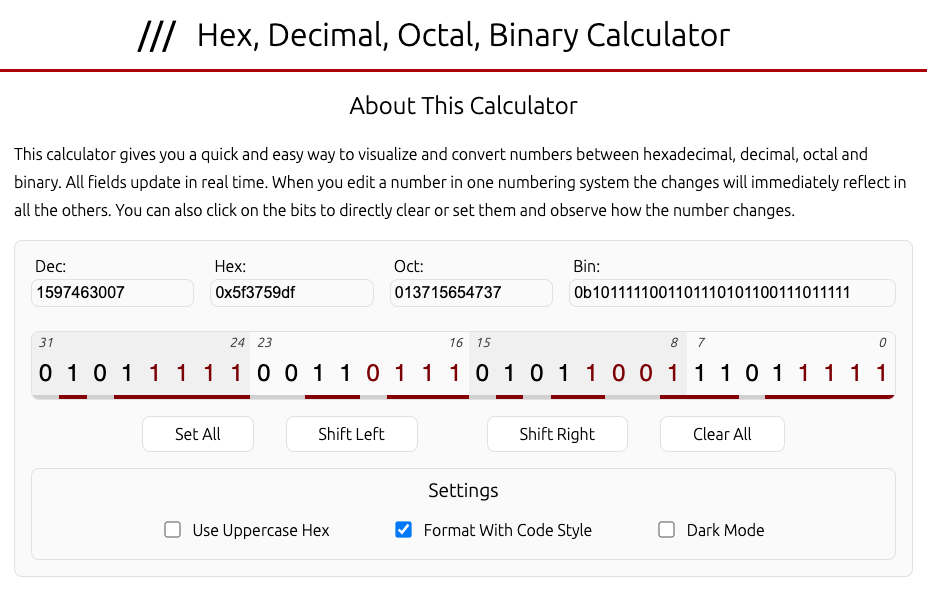Calc.50x.ca Programming Calculator
 calc.50x.ca is a free online utility I developed that converts numbers between Decimal, Hexadecimal, Octal, and Binary in real time. It also features the ability to directly set and clear bits in the binary representation. On the site you can read more about different numbering systems, as well as how to count to 1023 on two hands!
calc.50x.ca is a free online utility I developed that converts numbers between Decimal, Hexadecimal, Octal, and Binary in real time. It also features the ability to directly set and clear bits in the binary representation. On the site you can read more about different numbering systems, as well as how to count to 1023 on two hands!
The project is a replacement for the now-defunct calc.50x.eu - a similar calculator that I had used ever since I started developing my NES Emulator in 2014. However, on a day just like any other in November 2020, my workflow was broken! The utility was down! It seemed like the domain expired and someone else had bought it out and stuck a wordpress site on it.
For weeks I hoped that someone would make a suitable replacement… until I realized that someone could be me! I already had HTML and CSS experience, so all I needed was to learn enough Javascript to implement it. I had never used Javascript for web in any real capacity before, so I used my tried-and true method for learning a new technology: start at a blank text-editor and Google my way through until I’m done! Of course, having almost 10 years of experience with other programming languages means I usually have a solid idea of what to Google when I get stuck.
In addition to Javascript, I also took the opportunity to modernize my CSS skills by learning and using CSS Grid in the layout, as well as adopting a “mobile-first” design workflow for the first time.
In November 2021 (almost a year later), I spruced up the visuals and added support for bit shifting, code-like formatting, uppercase hexadecimal, 32-bit numbers, local storage of settings, and dark mode 😎.
Styling and Search Engine Optimization (SEO)
The CSS for the site was developed “mobile-first”. This means that the site was first designed for small screens. As the screen size is increased CSS rule tweaks are made to make better use of the available room. Designing mobile-first is unintuitive at first - after all, web development is primarily performed on a desktop or laptop computer with a larger screen. However, mobile now accounts for over half of the world’s web traffic. The Google indexer simulates a mobile device when it crawls the web and determines page quality and search rank, which makes having an excellent mobile site a requirement for search engine optimization (SEO). Finally, there are arguments that mobile-first forces designers to optimize their websites primarily for content, due to limited screen real-estate. “Content is key” is an expression that is commonly used in SEO circles that relates to this concept.
CSS Grid is a modern but well-supported styling technique and used in multiple places - notably in separating the page into header, main and footer sections, as well as in the layout of the bit-twiddle section. As the site stands currently, I believe I overused Grid in some cases where simple CSS or Flexbox would have done the job more efficiently. I plan to update the site as I continue to learn.
Converter Code
The code is about 200 lines long. Two event handlers are used for input handling, focus and input. The focus handler sets a flag telling the program which field was being edited last. The input event fires when the contents of an input box are changed, either by typing a character, backspacing, or pasting.
Each time the input event fires, the code reads the new value from the input box that previously triggered the focus event (it’s assumed that the input box must be focused before it can be edited). The new value may contain any number of new characters anywhere in the string, such as if the user pasted in the middle of the text. For this reason, the entire string is searched. Any time an invalid character is detected, it is stripped from the string. An invalid character is any character that is not represented by the radix (number base) corresponding to the input box. For example, the character ‘A’ would validate in hexadecimal but not decimal, octal or binary. Once the string is fully cleared, the resulting number is converted into all the other bases and the input boxes corresponding to the bases are set.
The “bit twiddle” section allows the user to directly set and clear bits in real time. Whenever a bit is clicked, a click event fires, which calculates the new number using bitwise operations on the number previously represented, and updates the fields accordingly.
Settings
In November 2021 I updated the app to support a few new settings - capitalized hexadecimal, code-like formatting and dark mode.
Capitalized hexadecimal representation was a feature request by someone that contacted me about the tool. A fairly easy implementation, simply capitalizing the hex output with .toUpperCase().
In various programming lanugages, numbers with bases other than 10 are represented in particular ways. Hexadecimal numbers have 0x at the front, for example 0x1234ABCD. Octal has a 0 at the front, like 0234 (differentiating it from 234 in decimal). Some compilers support binary literals that begin with 0b, and look like 0b11010110. I added an option to the calculator to have the numbers automatically format themselves in these ways (as well as accept pastes of numbers formatted such, like directly from source code). This was implemented by detecting and stripping away the leading characters before running the input through the validation routine described earlier. After the numeric input is validated, the leading characters are added back to the final output.
Every developer site has to have a dark mode. This was accomplished by creating a color palette for dark and light mode and assigning those colors to CSS variables. These colors would get auto-filled depending on the color-mode attribute of the <html> tag. I added a few background and border color transitions for extra style points.
All settings are stored and persist between visits. I simply store a key-value pair for each setting in LocalStorage. I had first tried using cookies, and although this approach worked, there was a lot of string operations involved. In comparison, the LocalStorage solution was simpler.
Challenges
I ran into some troubles with input validation, especially when testing on mobile devices. My original strategy was to validate each new character as it was typed. I set up a keypress event that would capture the keycode, convert the keycode to its corresponding character, then convert that character to a number and check for NaN in the radix (number base) corresponding whatever field the user was editing. If a value was validated, it would allow the keypress event through, otherwise its propagation would be blocked, effectively discarding it.
This seemed to work, but it had a few problems. The first problem was I needed to get the updated value so I could convert the other fields. I couldn’t get the updated value in the keypress event handler, because the value of the textbox only changes after the keypress event completes. I could have gotten the previous value and added in the new character, but I would have had to record the location of the caret, and insert the character in the right place in the string. My hacky solution was to add another event handler for input that would fire after the keypress was validated, and use that event to grab the new value and calculate the other fields. But that wasn’t the end of the problems. The second problem was that copying and pasting didn’t work reliably, so I had to escape the meta key and detect it in the keypress event and set up a paste handler. Finally (and most critically), I couldn’t type into the fields at all when using Android because it handles the keypress event differently.
I arrived at the final solution outlined in the previous section while trying to figure out how to validate paste data. In this situation I had multiple characters to validate, so I implemented a check of each sequentially until an invalid character was hit. If this happened I had planned to simply reject the whole paste, but realized that checking the whole string each time the input box value was changed was the solution to all my problems.
I also had some challenges with LocalStorage at first. I ran into issues getting the true/false states from LocalStorage, but the problem was that LocalStorage stores true and false as text. A “cast” was required before setting the checkbox values.
Conclusion
Many Google searches, one domain name registration and a few days later, I had my shiny new converter utility back in service. This project not only taught me Javascript and CSS Grid, it also taught me that I can be the change I wish to see in the world!


